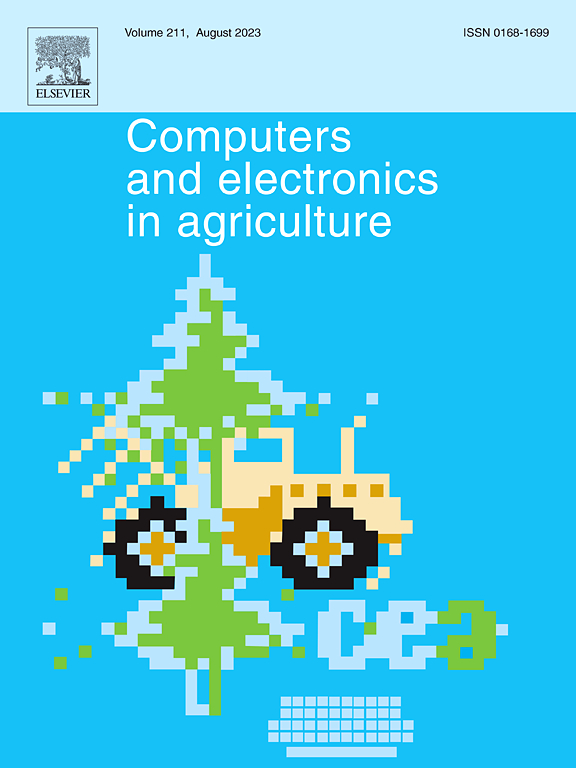Crop sample prediction and early mapping based on historical data: Exploration of an explainable FKAN framework
IF 7.7
1区 农林科学
Q1 AGRICULTURE, MULTIDISCIPLINARY
引用次数: 0
Abstract
Accurate and timely crop mapping is essential for food security assessment, and high-quality feature factors are the core foundation for accurate mapping. However, deep learning model crop classification algorithms have achieved some success, while the models themselves struggle to explain the specific contribution and impact of different features on the results. In this study, a self-adaptive Feature-attention Kolmogorov-Arnold Network (FKAN) is proposed for interpretable and scalable crop mapping. The model integrated the adaptive weighted feature attention module (AWFA) and the interpretable KAN network, which can visualize the complex associations between features and target crops and automatically capture and filter effective key spatiotemporal features, thus enhancing the interpretability of the model. Experimental results demonstrate that integrating optical, radar, and terrain features yields superior performance in both sample prediction and crop mapping, surpassing existing methods. The proposed FKAN achieves an overall accuracy and F1 score exceeding 0.90. Optical and radar features contribute the most significantly to classification accuracy, while terrain data provides complementary enhancement. By aligning with key crop phenology and leveraging the Google Earth Engine (GEE), FKAN establishes the first operational platform for global winter wheat identification, enabling accurate and scalable crop mapping. The migrated model achieves over 85% accuracy across different regions and years, demonstrating strong robustness and generalization capability. The study identifies optimal phenological periods and feature indices for different crops, providing scientific guidance for future mapping efforts. The FKAN model demonstrated robustness, scalability, and interpretability, was able to automatically extract high-confidence pixels and generate crop planting probabilities, providing an efficient and scalable solution for large-scale crop monitoring. This study generated the first global winter wheat map GlobalWinterWheat10m dataset by the FKAN algorithm. The code and demo link is accessible at https://github.com/FZUcheng123/FKAN.

基于历史数据的作物样本预测和早期制图:可解释的FKAN框架的探索
准确、及时的作物作图是粮食安全评价的基础,而高质量的特征因子是准确作图的核心基础。然而,深度学习模型作物分类算法已经取得了一些成功,而模型本身很难解释不同特征对结果的具体贡献和影响。本文提出了一种基于特征关注的自适应Kolmogorov-Arnold网络(FKAN),用于可解释和可扩展的作物映射。该模型集成了自适应加权特征关注模块(AWFA)和可解释的KAN网络,能够可视化特征与目标作物之间的复杂关联,自动捕获和过滤有效的关键时空特征,增强了模型的可解释性。实验结果表明,将光学、雷达和地形特征整合在一起,在样本预测和作物制图方面都取得了卓越的性能,超越了现有的方法。所提出的FKAN总体精度和F1分数均超过0.90。光学和雷达特征对分类精度的贡献最大,而地形数据则提供互补的增强。通过与关键作物物候相结合并利用谷歌地球引擎(GEE), FKAN建立了第一个全球冬小麦鉴定的操作平台,实现了准确和可扩展的作物制图。迁移后的模型在不同地区和年份的准确率达到85%以上,具有较强的鲁棒性和泛化能力。该研究确定了不同作物的最佳物候期和特征指数,为今后的制图工作提供了科学指导。FKAN模型具有鲁棒性、可扩展性和可解释性,能够自动提取高置信度像素并生成作物种植概率,为大规模作物监测提供了高效、可扩展的解决方案。本研究利用FKAN算法生成了首个全球冬小麦地图GlobalWinterWheat10m数据集。代码和演示链接可从https://github.com/FZUcheng123/FKAN访问。
本文章由计算机程序翻译,如有差异,请以英文原文为准。
求助全文
约1分钟内获得全文
求助全文
来源期刊

Computers and Electronics in Agriculture
工程技术-计算机:跨学科应用
CiteScore
15.30
自引率
14.50%
发文量
800
审稿时长
62 days
期刊介绍:
Computers and Electronics in Agriculture provides international coverage of advancements in computer hardware, software, electronic instrumentation, and control systems applied to agricultural challenges. Encompassing agronomy, horticulture, forestry, aquaculture, and animal farming, the journal publishes original papers, reviews, and applications notes. It explores the use of computers and electronics in plant or animal agricultural production, covering topics like agricultural soils, water, pests, controlled environments, and waste. The scope extends to on-farm post-harvest operations and relevant technologies, including artificial intelligence, sensors, machine vision, robotics, networking, and simulation modeling. Its companion journal, Smart Agricultural Technology, continues the focus on smart applications in production agriculture.
 求助内容:
求助内容: 应助结果提醒方式:
应助结果提醒方式:


